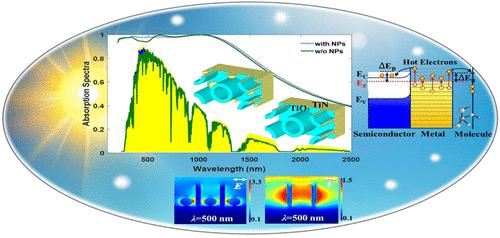促进等离子体纳米粒子在TiO2/TiN纳米腔中的热电子生成用于太阳能转换
IF 3.2
3区 化学
Q2 CHEMISTRY, PHYSICAL
引用次数: 0
摘要
在先进的纳米光子应用中,热电子的高效产生和收获仍然是一个关键的挑战。在这里,我们提出了一种新的策略,通过将等离子体纳米粒子(NPs)──包括Au、Ag、Pt和TiN──加入TiO2/TiN纳米腔中来促进HE的产生。虽然我们之前对TiO2/TiN纳米管阵列的研究在200-1300 nm范围内获得了良好的光吸收,但在350-600 nm可见光范围内吸收较弱。为了克服这一限制,我们用等离子体NPs修饰纳米结构。综合分析、时域有限差分(FDTD)和有限元方法(FEM)模拟表明,纳米腔模式和等离子体Mie共振之间存在强耦合,导致可见光范围内的吸收显著增强。在被测试的材料中,放置在纳米空腔底部的70 nm TiN NPs表现出最佳性能,在光学和成本效率方面都优于贵金属。HE生成的量子力学分析表明,TiO2/TiN纳米腔内的TiN NPs在600 nm波长下的热载流子生成速率为~ 1014 s-1,与贵金属相比具有红移的光谱响应。观察到的HE增强归因于Mie共振引起的局部电场(热点)。这些发现为先进的热电子器件工程铺平了道路,在光电探测器、光催化和可见光谱中的太阳能转换方面具有潜在的应用前景。本文章由计算机程序翻译,如有差异,请以英文原文为准。

Boosting Hot Electron Generation of Plasmonic Nanoparticles in TiO2/TiN Nanocavities for Solar Energy Conversion
The efficient generation and harvesting of hot electrons (HEs) remains a key challenge in advanced nanophotonic applications. Here, we propose a novel strategy to boost HE generation by incorporating plasmonic nanoparticles (NPs)─including Au, Ag, Pt, and TiN─into TiO2/TiN nanocavities. While our previous study on TiO2/TiN nanotube arrays achieved excellent optical absorption across 200–1300 nm, it showed weak absorption in the 350–600 nm visible range. To overcome this limitation, we decorate the nanostructure with plasmonic NPs. Comprehensive analytical, finite-difference time-domain (FDTD), and finite element method (FEM) simulations reveal strong coupling between nanocavity modes and plasmonic Mie resonances, leading to significantly enhanced absorption in the visible range. Among the examined materials, the optimized 70 nm TiN NPs placed at the bottom of the nanocavity demonstrate the best performance, outperforming noble metals in both optical and cost efficiency. Quantum mechanical analysis of HE generation shows that the TiN NPs within TiO2/TiN nanocavities achieve a hot carrier generation rate of ∼1014 s–1 at a wavelength of 600 nm, with a red-shifted spectral response compared to noble metals. The observed HE enhancement is attributed to localized electric fields (hot spots) induced by Mie resonances. These findings pave the way for advanced hot electron device engineering with potential applications in photodetectors, photocatalysis, and solar energy conversion in the visible spectrum.
求助全文
通过发布文献求助,成功后即可免费获取论文全文。
去求助
来源期刊

The Journal of Physical Chemistry C
化学-材料科学:综合
CiteScore
6.50
自引率
8.10%
发文量
2047
审稿时长
1.8 months
期刊介绍:
The Journal of Physical Chemistry A/B/C is devoted to reporting new and original experimental and theoretical basic research of interest to physical chemists, biophysical chemists, and chemical physicists.
 求助内容:
求助内容: 应助结果提醒方式:
应助结果提醒方式:


